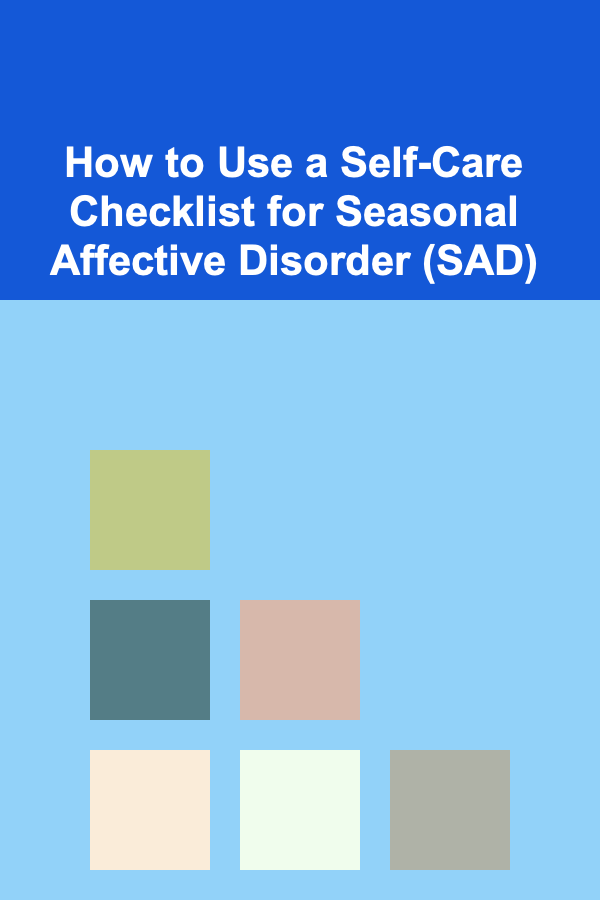
How to Use a Self-Care Checklist for Seasonal Affective Disorder (SAD)
ebook include PDF & Audio bundle (Micro Guide)
$12.99$11.99
Limited Time Offer! Order within the next:

Seasonal Affective Disorder (SAD) is a type of depression that occurs at certain times of the year, most commonly in the winter months when daylight is limited. Those affected by SAD may experience symptoms such as fatigue, lack of motivation, irritability, and difficulty concentrating. Although it's more common during the winter, some individuals may experience SAD in the summer months as well. As the days grow shorter and the weather changes, it can become harder to maintain a positive mindset, but there are various self-care strategies that can help manage the symptoms and improve overall well-being.
One of the most effective ways to handle SAD is by creating a structured approach to self-care. A self-care checklist specifically tailored to the symptoms and challenges of SAD can be a powerful tool to stay on track and prioritize mental health. This article outlines how to build a self-care checklist for Seasonal Affective Disorder and the key steps to incorporate into your daily routine.
Understanding Seasonal Affective Disorder (SAD)
Before diving into the self-care checklist, it's important to understand the nature of SAD. According to the American Psychiatric Association, SAD is considered a form of major depressive disorder that occurs at a specific time of year, usually during the colder months when the days are shorter. While it can affect anyone, it is more common in regions that experience long winters, and in individuals with a history of depression or other mood disorders.
The symptoms of SAD may include:
- Low energy or fatigue
- Trouble sleeping (hypersomnia or insomnia)
- Difficulty concentrating
- Loss of interest in activities once enjoyed
- Changes in appetite or weight (typically craving carbohydrates)
- Feeling hopeless or worthless
- Social withdrawal or isolation
These symptoms can vary in severity, and in some cases, they can disrupt daily functioning. Understanding how SAD affects your emotional and physical well-being is the first step to managing it.
Creating Your Self-Care Checklist
A self-care checklist for SAD can help you build healthy routines, stay consistent with positive behaviors, and monitor your progress. By focusing on daily activities that improve mental, emotional, and physical health, you can mitigate some of the more challenging symptoms of SAD. Here's how you can structure your checklist:
1. Daily Exposure to Natural Light
One of the most common treatments for SAD is light therapy. Natural sunlight boosts serotonin levels and helps regulate your body's circadian rhythms. Even on cloudy days, daylight exposure can make a significant difference in how you feel.
Action Items:
- Morning light exposure: Aim to get at least 30 minutes of sunlight in the morning. This could involve going for a walk outside or sitting near a window that lets in natural light.
- Lightbox therapy: If you live in an area with limited sunlight during the winter, consider using a lightbox. These devices simulate natural sunlight and can be especially effective when used for 20-30 minutes every morning.
2. Regular Exercise
Exercise is a powerful tool for managing depression and anxiety. It releases endorphins, the body's natural mood boosters, and helps reduce symptoms of fatigue, anxiety, and stress. Physical activity can also improve sleep, another common issue for individuals with SAD.
Action Items:
- Exercise for 30 minutes a day: Engage in any form of exercise you enjoy, whether it's walking, jogging, yoga, or strength training. Regular aerobic exercise is particularly effective for improving mood.
- Outdoor exercise: If possible, try to incorporate outdoor activities into your routine, such as hiking, cycling, or simply walking in nature. This will provide both physical and emotional benefits.
3. Balanced Diet
The foods we eat can have a significant impact on our mood and energy levels. A well-balanced diet rich in nutrients can help stabilize blood sugar levels, improve brain function, and support overall mental health. Conversely, poor nutrition can contribute to feelings of fatigue, irritability, and mood swings.
Action Items:
- Eat a nutrient-dense breakfast: Include protein, healthy fats, and complex carbohydrates. For example, try oatmeal with nuts, seeds, and berries, or eggs with avocado and whole-grain toast.
- Limit sugar and refined carbs: Processed foods, sugary snacks, and refined carbohydrates can cause blood sugar spikes and crashes, contributing to irritability and mood swings.
- Include omega-3 rich foods: Omega-3 fatty acids are known to support brain health and mood regulation. Incorporate fatty fish like salmon, chia seeds, and walnuts into your diet.
4. Prioritize Sleep Hygiene
Sleep disturbances are common in individuals with SAD, whether it's oversleeping or insomnia. Establishing healthy sleep habits, also known as sleep hygiene, can help improve the quality of your rest and make it easier to wake up feeling refreshed.
Action Items:
- Maintain a regular sleep schedule: Try to go to bed and wake up at the same time every day, even on weekends. Consistency helps regulate your body's internal clock.
- Limit screen time before bed: The blue light from electronic devices can interfere with the production of melatonin, a hormone that regulates sleep. Aim to avoid screens for at least 30 minutes before bedtime.
- Create a relaxing bedtime routine: Engage in calming activities, such as reading, meditation, or a warm bath, to signal to your body that it's time to wind down.
5. Mindfulness and Meditation
Mindfulness practices can significantly reduce feelings of anxiety and depression. Meditation and deep-breathing exercises can help you manage stress, ground yourself in the present moment, and improve your overall emotional well-being.
Action Items:
- Practice mindfulness: Spend 5-10 minutes daily practicing mindfulness. Focus on your breathing and notice how your body feels in the present moment.
- Try guided meditation: Use apps like Calm or Headspace for guided meditations that help you relax and stay centered.
- Breathing exercises: Incorporate deep breathing exercises, such as the 4-7-8 method, to reduce stress and anxiety.
6. Social Connection and Support
Social isolation can worsen symptoms of SAD. Connecting with others, whether through family, friends, or support groups, provides emotional support, reduces loneliness, and helps maintain a sense of belonging.
Action Items:
- Schedule regular check-ins: Reach out to family members or friends for regular phone calls or video chats. Having someone to talk to can provide emotional support and strengthen relationships.
- Join a support group: Consider joining an online support group for individuals with SAD, where you can share experiences and coping strategies with others who understand.
- Engage in social activities: Even when you feel like isolating yourself, try to push through by engaging in social activities, such as coffee dates, group exercise, or community events.
7. Cognitive Behavioral Therapy (CBT)
Cognitive Behavioral Therapy (CBT) is one of the most effective forms of psychotherapy for treating depression and anxiety. CBT helps individuals identify and challenge negative thought patterns, replacing them with more realistic and positive beliefs.
Action Items:
- Consider therapy: Seek the help of a licensed therapist who specializes in CBT to work through your symptoms of SAD.
- Journaling: Try writing down your thoughts and feelings each day. Reflecting on your emotions can help you identify negative thought patterns and replace them with more positive outlooks.
8. Consider Medication
In some cases, individuals with severe SAD may benefit from medication. Antidepressants, such as selective serotonin reuptake inhibitors (SSRIs), can be effective in regulating mood and alleviating symptoms.
Action Items:
- Consult with a doctor: If your symptoms of SAD are significantly impacting your life, talk to your doctor about potential medication options. A healthcare professional can help you weigh the benefits and risks of treatment.
9. Engage in Activities You Enjoy
Even when you're feeling low, try to engage in activities that bring you joy. Participating in hobbies and creative outlets can help distract you from negative thoughts, improve your mood, and boost your sense of accomplishment.
Action Items:
- Engage in hobbies: Dedicate time to activities that make you feel happy, whether it's reading, cooking, gardening, or painting.
- Set small goals: Create achievable, small goals each day that contribute to your sense of fulfillment and purpose.
10. Seek Professional Help When Needed
If your symptoms become overwhelming or you're struggling to manage them on your own, don't hesitate to seek professional help. A therapist or counselor can provide guidance, support, and strategies for dealing with SAD.
Action Items:
- Talk to a mental health professional: If your symptoms of SAD are preventing you from functioning or causing significant distress, schedule an appointment with a mental health professional who can provide therapy or recommend treatment options.
Conclusion
Managing Seasonal Affective Disorder requires a multi-faceted approach that includes lifestyle changes, healthy habits, and professional support. By using a self-care checklist, you can implement strategies that help you manage the symptoms of SAD and improve your overall well-being. Prioritizing light exposure, exercise, nutrition, and sleep, while also seeking emotional support and therapy, can make a significant difference in how you feel during the seasonal transitions. With consistent effort and self-care, you can reduce the impact of SAD and thrive even during the most challenging months.
Reading More From Our Other Websites
- [Organization Tip 101] How to Use Scent and Lighting for a Harmonious Shared Space
- [Home Space Saving 101] How to Elevate Your Decor and Storage with Stylish Floating Shelves
- [Organization Tip 101] How to Set Up a Digital Filing System for Your Business
- [Organization Tip 101] How to Set Up a Dust Collection System in a Small Workshop
- [Star Gazing Tip 101] Night Sky Narratives: A Journey Through Global Mythology While Stargazing
- [Personal Finance Management 101] How to Save for Retirement at Any Age
- [Survival Kit 101] How to Choose the Right Emergency Preparedness Kits for Your Family
- [Personal Care Tips 101] How to Choose a Mouthwash That's Safe for Children
- [Digital Decluttering Tip 101] Best Digital Photo Archiving Methods for Amateur Photographers
- [Home Soundproofing 101] How to Use Heavy Fabrics for Soundproofing: Curtains, Rugs, and Upholstery Ideas

How To Build a Consistent Language Learning Habit
Read More
How to Categorize Household Items for Efficient Inventory Management
Read More
How to Declutter Your Home as a Family Project
Read More
How to Handle Pet Shedding in Your Home Year-Round
Read More
How to Understand Energy Audits for Renewable Integration
Read More
How To Use Social Media for Language Learning
Read MoreOther Products

How To Build a Consistent Language Learning Habit
Read More
How to Categorize Household Items for Efficient Inventory Management
Read More
How to Declutter Your Home as a Family Project
Read More
How to Handle Pet Shedding in Your Home Year-Round
Read More
How to Understand Energy Audits for Renewable Integration
Read More